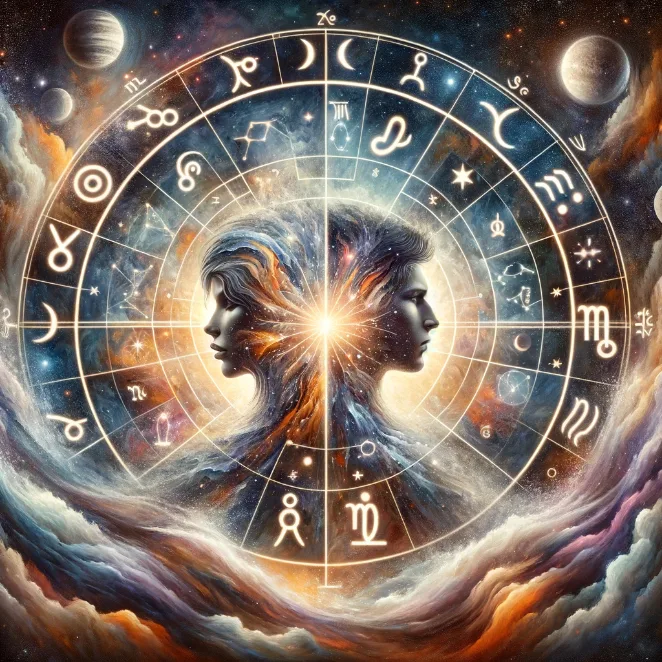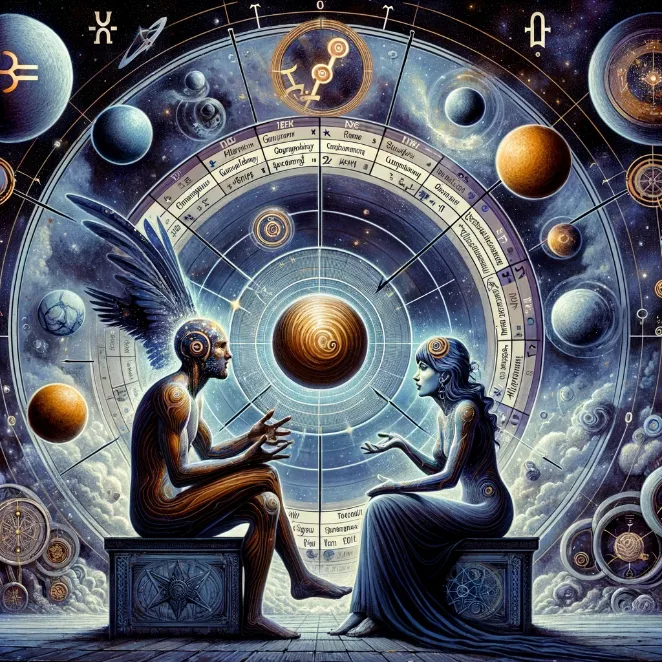
Composite Charts: The Astrological Blueprint of a Relationship
Composite charts in astrology offer a distinctive and powerful lens through which to view relationships. Unlike individual birth charts, a composite chart represents the fusion of two individuals’ energies, creating a unique astrological profile for the relationship itself. This chart is not about individual desires or destinies but about the shared path and collective destiny of the couple. It reveals how two people come together, highlighting the strengths they can draw upon and the challenges they may face as a unit. By studying a composite chart, partners gain valuable insights into the essence of their relationship, guiding them toward a deeper understanding and more meaningful connection.
article by Sofia Ferguson
Unveiling the Composite Sun: The Relationship's Core
The Sun in a composite chart is a critical component, acting as the heart of the relationship. It symbolizes the core identity, purpose, and overall direction of the partnership. The sign and house placement of the Sun can reveal much about the nature and focus of the relationship. For example, a composite Sun in Aries might indicate a relationship full of initiative and enthusiasm, while a Sun in Libra could suggest a partnership that values harmony and balance. The aspects the Sun forms with other planets also provide insights into the dynamics at play, highlighting areas of ease and potential conflict. Understanding the composite Sun's position helps partners align with their relationship’s primary energy, fostering unity and shared goals.
Moon’s Influence: Emotional Landscape
The Moon's placement in a composite chart sheds light on the emotional undercurrents of the relationship. It reveals how emotions are shared, processed, and nurtured within the partnership. The sign and house of the Moon indicate the couple's emotional needs and how they find comfort and security together. Challenging aspects to the Moon may point to emotional misunderstandings or sensitivities that need attention. Conversely, harmonious aspects suggest an intuitive emotional connection and mutual understanding. The Moon's position can guide couples in creating a nurturing and emotionally supportive environment, essential for the relationship's health and longevity.

Mercury's Role: Communication Patterns
Mercury's position in a composite chart plays a crucial role in how partners communicate, think, and perceive the world together. It illustrates the style and effectiveness of communication within the relationship. A well-aspected Mercury can indicate clear, open, and stimulating conversations, while challenging aspects might suggest misunderstandings or communication blocks. Understanding Mercury's influence can help couples identify and improve their communication strategies, ensuring both partners feel heard and understood. This awareness fosters a deeper connection and helps prevent unnecessary conflicts caused by miscommunication.
Venus and Mars: Love and Passion
In a composite chart, Venus and Mars represent the yin and yang of the relationship, highlighting the balance between love and desire. Venus shows how affection, appreciation, and harmony are experienced and expressed, while Mars indicates the couple's sexual energy and assertiveness. The interaction between these two planets can reveal much about the romantic and physical dynamics of the relationship. Positive aspects suggest a natural flow and mutual satisfaction, while challenging aspects may point to areas needing adjustment or understanding. By exploring the nuances of Venus and Mars, couples can work towards enhancing their romantic and sexual compatibility.
The Impact of Outer Planets
The influence of outer planets in a composite chart is significant, often marking major themes and long-term trends in the relationship. Jupiter's placement indicates areas of growth and expansion, while Saturn highlights responsibilities and challenges. Uranus brings elements of change and innovation, Neptune adds a layer of dreams and spirituality, and Pluto represents transformation and power dynamics. These planets can profoundly shape the relationship's evolution, presenting opportunities for growth and tests of resilience. Understanding their impact helps couples prepare for and navigate these overarching themes, aligning their joint journey with the broader cosmic influences at play.
Composite Chart Houses: Setting the Stage
The houses in a composite chart pinpoint where the energies of the relationship are most likely to manifest. Planets in the 7th house, for instance, might emphasize the importance of partnership and collaboration, while those in the 2nd house could focus on shared values and resources. Each house offers a context for understanding how the relationship functions in various life areas. This analysis can guide couples in prioritizing their efforts and understanding the external influences that shape their relationship.
Creating a Composite Chart: The Astrological Process
To create a composite chart, the midpoints between each partner's corresponding planetary positions are calculated. This involves finding the middle point between each planet, the Ascendant, and the Midheaven from both individuals’ natal charts. For example, if one partner’s Sun is at 10 degrees Aries and the other’s Sun is at 10 degrees Leo, the composite Sun would be at 10 degrees Gemini. This midpoint method is applied to all planetary positions and angles, resulting in a new chart that symbolically represents the relationship. This composite chart is then interpreted much like a natal chart, offering insights into the relationship's strengths, challenges, and potential growth areas.
The Power of Synthesis: Blending Two Lives
A composite chart is more than a technical astrological tool; it symbolizes the blending of two lives into a shared journey. It highlights how individual energies and destinies intertwine to create a unique path. By studying their composite chart, partners can better understand how their individual traits complement and challenge each other. This synthesis of energies can bring a deeper appreciation of the relationship’s purpose and potential, guiding couples toward greater harmony and shared fulfillment.

Composite charts provide an invaluable astrological blueprint for understanding the dynamics of a relationship. By exploring this chart, couples can gain profound insights into how their energies merge, what challenges they may face, and how they can grow together. This astrological approach offers a unique perspective on love, encouraging partners to navigate their relationship with greater awareness and depth. In the journey of love, a composite chart can be a guiding star, illuminating the path to a more harmonious and fulfilling partnership.
Published: 11/24/2023
Modified: 1/26/2024
More predictions
Come back here soon to learn more about yourself and your future


Synastry's Astrological Houses: The Blueprint for Relationship Harmony
Astrological houses in synastry offer a profound and nuanced view of relationship dynamics. Each house represents a unique area of life, and when we explore how our partner's planets fall into these houses in our own chart, we unlock a world of deep insights. This celestial guide provides an understanding of how two individuals blend their energies in various aspects of life, from personality expression to career, home life, and more. Let's embark on a journey through each astrological house to discover how they lay the foundations for strong, harmonious relationships.


Transits in Synastry: Guiding Relationship Tides
The cosmos plays a pivotal role in the dance of relationships, with planetary transits acting as key influencers in the dynamics between partners. In astrology, these transits – the movement of planets across different points in the natal charts – can have profound effects on relationships, known as synastry. As planets move and form aspects with positions in our own and our partner's charts, they trigger various energies and themes. This celestial interplay can enhance compatibility, bring challenges to the surface, or catalyze growth and change. Understanding the impact of planetary transits on synastry helps couples navigate through different phases of their relationship, making sense of the ebbs and flows in their connection.


Numerology’s Expression Number: Voicing the Soul of a Relationship
In the fascinating study of numerology, the Expression Number serves as a crucial key to unlocking an individual's characteristics and predispositions, especially in the context of relationships. Derived from a person's full birth name, this number offers a glimpse into one’s innate personality, strengths, weaknesses, and the ways they interact in love and partnership. It acts as a guide to understanding one's approach to communication, conflict resolution, and emotional expression. In a relationship, exploring the Expression Numbers of both partners can provide invaluable insights, revealing how two unique personalities can coexist, complement, and sometimes challenge each other. This introspective journey into numerology can illuminate paths to deeper understanding and empathy, paving the way for more harmonious and fulfilling partnerships.